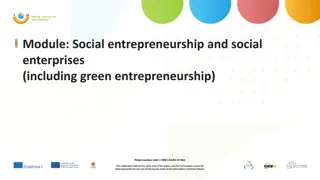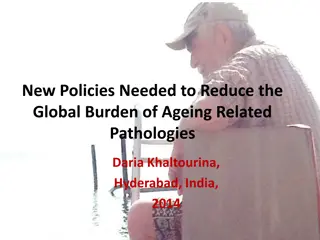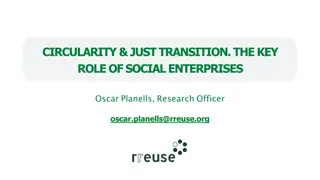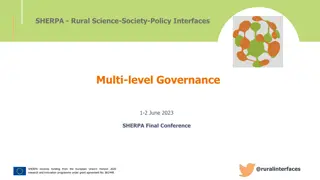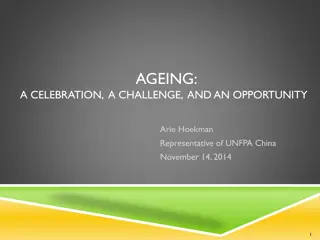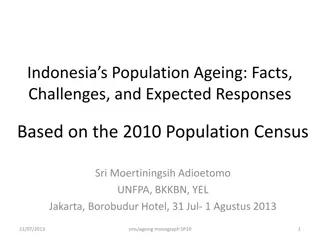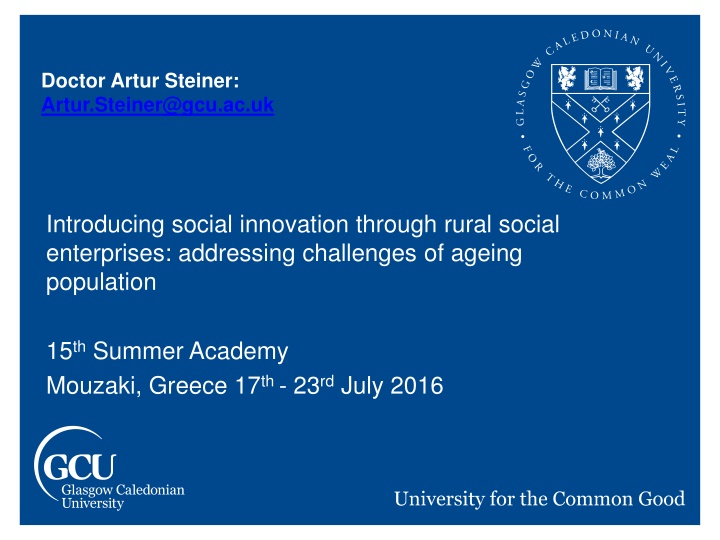
Innovative Approaches to Addressing Social Challenges
Learn about social innovation, social enterprises, and sustainable solutions for addressing social problems. Explore the role of governments and the benefits of social enterprise in promoting effective solutions. Discover the freedom and flexibility social enterprises offer in tackling societal issues efficiently and creatively.
Download Presentation

Please find below an Image/Link to download the presentation.
The content on the website is provided AS IS for your information and personal use only. It may not be sold, licensed, or shared on other websites without obtaining consent from the author. If you encounter any issues during the download, it is possible that the publisher has removed the file from their server.
You are allowed to download the files provided on this website for personal or commercial use, subject to the condition that they are used lawfully. All files are the property of their respective owners.
The content on the website is provided AS IS for your information and personal use only. It may not be sold, licensed, or shared on other websites without obtaining consent from the author.
E N D
Presentation Transcript
Doctor Artur Steiner: Artur.Steiner@gcu.ac.uk Introducing social innovation through rural social enterprises: addressing challenges of ageing population 15thSummer Academy Mouzaki, Greece 17th - 23rdJuly 2016
What is social innovation? A social innovation is a novel solution to a social problem that is more effective, efficient, sustainable, or just than current solutions. The value created accrues primarily to society rather than to private individuals.
Social enterprise and social innovation SEs use business solutions to achieve public good SEs invest financial surplusesto address social challenges SEs operate independently of the State
Sustainable Solutions to Social Problems
Governments and social policy Failure of different political systems to meet social needs Limits of governments as the vehicle of social problem solving Drawbacks of large-scale, top-down government programs
Governments and social policy Decentralisation is critical because finding what works depends on having the right knowledge, being able to envision new combinations, and having the freedom to test ideas through action Social enterprise and social entrepreneurship considered as an element of a potential solution
Social enterprise as a social innovation Ability to explore a wider range of alternatives as opposed to standardised interventions Greater freedom of action than governmental agencies Freedom and flexibility due to lack of bureaucratic rules, legislative mandates, political considerations, and a fixed budget Ability to move more quickly than public officials and take risk
Social entreprise as a social innovation Ability to earn income from business ventures Access to private resources and private contributions such as voluntary gifts of money, time, and in-kind donations as well as public money devoted to the same problem Ability to tailor efforts to different communities or markets
Social Enterprise in Scotland
Social enterprises and policies Major interest in social enterprises Popularisation of the idea of non-state players working in partnership with the state Scottish and the UK governments want social enterprises to grow BUT How to develop more social enterprises?
Drivers of social innovation through the lens of policy initiatives Bottom up: driven by communities (rather than government and other powerful organisations) Empowerment: the process by which disadvantaged communities define their own needs and determine the response that is made to them Capacity Building: raising people s knowledge, awareness and skills to use their own capacity to tackle their needs
Social enterprises in Scotland More than 5000 social enterprises in Scotland 3.63bn - annual income 1.15bn - in traded income 66% - expect their income to increase next year 54% - generate half or more of their income from trading 68% - sell directly to the general public 8.77bn - in combined assets
Social enterprises in numbers 45% - operate with the stated objective of creating employment More than 112,000 employees Nearly 70,000 volunteers supporting the delivery of SE activity 60% - led by a woman 42% of social enterprises formed in the last 10 year 200+ new social enterprises forming each year
Contribution of Social Enterprise to social innovation a case study of rural Scotland
SEs in the Highlands and Islands Scottish Highlands and Islands Is the most remote and rural area in Scotland and one of the most sparsely populated areas in the EU. Only 9% of Scottish population lives in the Highlands and Islands. Yet, 22% of all Scottish SEs are located in the area.
Geographical location of the study Scottish Highlands
Example of community social entrepreneurship programme O4O = Older People for Older People Why older people? Demographic changes and apocalyptic scenarios Current perception of older people Challenges in service provision especially in remote and rural areas
Some facts Projected Health and Social care expenditure for Scottish populatiion aged 65+ 9,000 74% 8,000 7,000 6,000 22% 5,000 m 4,000 3,000 2,000 1,000 0 2007/08 Actual 2011 2016 2021 2026 2031 NHS Social Work Projecting costs of Health and Social care on the basis of demographic change would see the costs rise by just over 1bn by 2016 (a 22% rise) and by 3.5bn by 2031 (a 74% rise).
Some facts Increasing proportion of older people living in Europe In Scotland, from 2008: 65+ population projected to rise 62% by 2031 For the 85+ age group specifically, a 144% rise is projected by 2031 Remote, rural and peripheral areas have a higher percentage of older people than more central urban regions
Background of the O4O Economic and socio-demographical changes Financial crisis, decreasing public spending, ageing population Increasing role for communities to do more things independently from the state Social enterprise policy presented as a potential solution to current challenges Examples: Consequences: How this can happen? O4O tested current policies 26
O4O aims - To promote older people as a positive force - To help maintain people living in their own communities for as long as possible - To involve older people in producing O4O organisations and services
O4O theory and action research Older people remain active for longer Engagement of older people in O4O Trust and social networks develop O4O organisations deliver services for other older people Increased community capacity Positive impact on physical and mental health Reduced dependence on the State as a provider
Process of O4O creation Support from O4O: Community Action - Meet community Community identify needs - Publicity - Building capacity - Generate confidence/ enthusiasm - Building confidence Community engage in O4O concept - Avoiding duplication - Discussion with community - Accessing finance Initiatives selected to take forward - Accessing information - Building trust Social organisation model established Community action/ entrepreneurship - Skills needed -Business planning - Community capacity - Models of social organisation - Community takes on roles - Resources - Training O4O delivers services
Innovative O4O services 3 out of 4 communities were successful in implementing O4O project O4O projects facilitated development of products and services including - Transport services - Day care centre - Heritage project
O4O examples T4T: Transport for Tongue - Provides Transport services including: - Informal connecting of people to share lifts - Formal volunteering for the car scheme - Demand responsive service and minibus hire
O4O examples Lochinver day care centre -Community Care Assynt -A community business created by the Assynt Centre Action Group
O4O examples Ardersier heritage project: - Oral history DVD - Development of community buildings
What does it all mean?
Social innovation in O4O PROBLEM 1: Ageing population + PROBLEM 2: Rural service delivery SOLUTION: Rural service delivery by older people
Social innovation in O4O 1. Older people perceived as asset rather than burden to our society 2. O4O organisations based on community needs with flexible management systems 3. O4O organisations generate social, economic and added value 4. Community capacity building as an integral part of O4O organisations
Findings and implications Entrepreneurial tools used by social enterprises might not be innovative. However, it is the outcome of their activities that brings social innovation Rural context is important in shaping up socially entrepreneurial opportunities and social innovation Social enterprises capable of implementing specific social innovations in their local settings
Useful O4O reading Munoz, S-A., Steiner, A. and Farmer, J. (2015) Processes of Community-Led Social Enterprise Development: Learning from the Rural Context, Community Development Journal, pp.50(3):478-493. Munoz, S-A., Steinerowski, A., Farmer, J. and Stephen, K. (2011) Community Social Enterprises as a Response to the Service Needs of Ageing Rural Populations. Journal of Social Management, 2(September), pp.23-43. Farmer, J., Munoz, S-A., Steinerowski, A. and Bradley, S. (2011) Health, wellbeing and community involvement of older people in rural Scotland. In L , Q. (ed.) Health and Wellbeing: A social and cultural perspective, pp. 127-142. New York, Nova Science Publishers. Steinerowski, A., Bradley, S., Munoz, S-A., Farmer J. and Fielding, S. (2011) Participation for Health and Wellbeing: Factors Associated with Older People s Participation in Remote and Rural Communities. In: Angus, D. and Boutsioli, Z. (eds) Health Studies: Economics, Management and Policy, ATINER, pp.189-200. Munoz, S-A. and Steinerowski, A. (2012) Socially entrepreneurial skills and capabilities in a rural context. In Farmer, J., Hill, C., Munoz, S-A. (eds) Community Co-production - Social Enterprises in Remote and Rural Communities, Cheltenham, UK, Edward Elgar, pp.75-92.
Group task Think about your local context and local challenges. Could social enterprises introduce social innovation and address those challenges? How this would happen? What resources and/or support would be needed? Can you identify any ways to combine challenges in order to create a solution?
Group task Bottom-up social enterprise social innovation versus Supported social enterprise social innovation. Discuss advantages, disadvantages, similarities and differences of both approaches.




